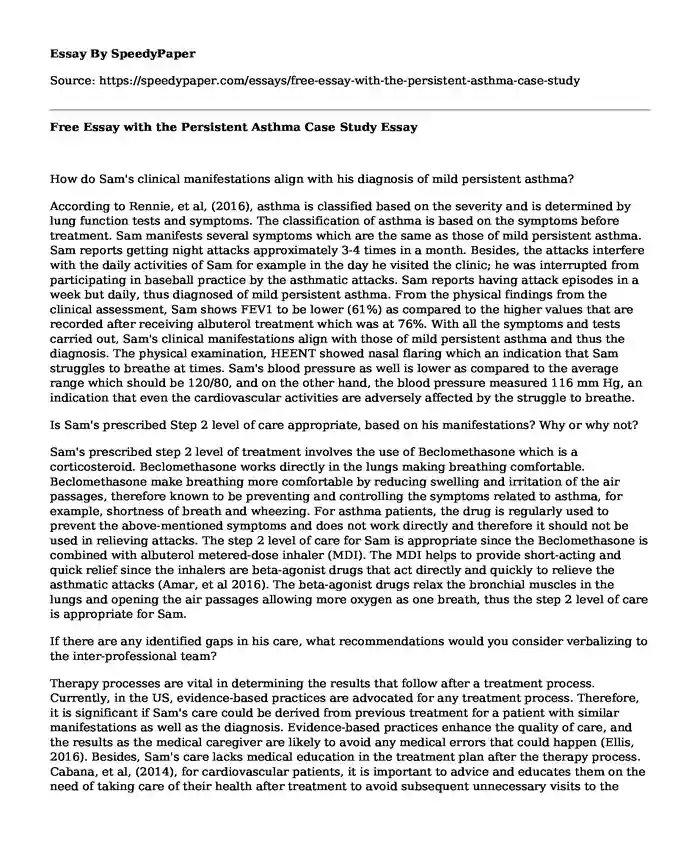
| Type of paper: | Course work |
| Categories: | Medicine Pharmacology |
| Pages: | 3 |
| Wordcount: | 696 words |
How do Sam's clinical manifestations align with his diagnosis of mild persistent asthma?
According to Rennie, et al, (2016), asthma is classified based on the severity and is determined by lung function tests and symptoms. The classification of asthma is based on the symptoms before treatment. Sam manifests several symptoms which are the same as those of mild persistent asthma. Sam reports getting night attacks approximately 3-4 times in a month. Besides, the attacks interfere with the daily activities of Sam for example in the day he visited the clinic; he was interrupted from participating in baseball practice by the asthmatic attacks. Sam reports having attack episodes in a week but daily, thus diagnosed of mild persistent asthma. From the physical findings from the clinical assessment, Sam shows FEV1 to be lower (61%) as compared to the higher values that are recorded after receiving albuterol treatment which was at 76%. With all the symptoms and tests carried out, Sam's clinical manifestations align with those of mild persistent asthma and thus the diagnosis. The physical examination, HEENT showed nasal flaring which an indication that Sam struggles to breathe at times. Sam's blood pressure as well is lower as compared to the average range which should be 120/80, and on the other hand, the blood pressure measured 116 mm Hg, an indication that even the cardiovascular activities are adversely affected by the struggle to breathe.
Is Sam's prescribed Step 2 level of care appropriate, based on his manifestations? Why or why not?
Sam's prescribed step 2 level of treatment involves the use of Beclomethasone which is a corticosteroid. Beclomethasone works directly in the lungs making breathing comfortable. Beclomethasone make breathing more comfortable by reducing swelling and irritation of the air passages, therefore known to be preventing and controlling the symptoms related to asthma, for example, shortness of breath and wheezing. For asthma patients, the drug is regularly used to prevent the above-mentioned symptoms and does not work directly and therefore it should not be used in relieving attacks. The step 2 level of care for Sam is appropriate since the Beclomethasone is combined with albuterol metered-dose inhaler (MDI). The MDI helps to provide short-acting and quick relief since the inhalers are beta-agonist drugs that act directly and quickly to relieve the asthmatic attacks (Amar, et al 2016). The beta-agonist drugs relax the bronchial muscles in the lungs and opening the air passages allowing more oxygen as one breath, thus the step 2 level of care is appropriate for Sam.
If there are any identified gaps in his care, what recommendations would you consider verbalizing to the inter-professional team?
Therapy processes are vital in determining the results that follow after a treatment process. Currently, in the US, evidence-based practices are advocated for any treatment process. Therefore, it is significant if Sam's care could be derived from previous treatment for a patient with similar manifestations as well as the diagnosis. Evidence-based practices enhance the quality of care, and the results as the medical caregiver are likely to avoid any medical errors that could happen (Ellis, 2016). Besides, Sam's care lacks medical education in the treatment plan after the therapy process. Cabana, et al, (2014), for cardiovascular patients, it is important to advice and educates them on the need of taking care of their health after treatment to avoid subsequent unnecessary visits to the medicals facility for cases that can be handled at home. Thus it is essential to include a health education session after treatment of patients suffering from such infections.
References
Amar, N. J., Moss, M. H., Kerwin, E. M., Li, J., & Small, C. J. (2016, September). Safety and efficacy of beclomethasone dipropionate delivered by breath-actuated or metered-dose inhaler for persistent asthma. In Allergy and asthma proceedings (Vol. 37, No. 5, pp. 359-369). OceanSide Publications, Inc.
Cabana, M. D., Slish, K. K., Evans, D., Mellins, R. B., Brown, R. W., Lin, X., ... & Clark, N. M. (2014). Impact of physician asthma care education on patient outcomes. Health Education & Behavior, 41(5), 509-517.
Ellis, P. (2016). Evidence-based practice in nursing. Learning Matters.Rennie, D. C., Senthilselvan, A., Dyck, R., Afanasieva, A., Adamko, D. J., Lawson, J. A., & Oluwole, O. (2017). Asthma Diagnosis Along An Urban-Rural Gradient In Saskatchewan, Canada. Am J Respir Crit Care Med, 195, A4810.
Cite this page
Free Essay with the Persistent Asthma Case Study. (2022, Mar 23). Retrieved from https://speedypaper.net/essays/free-essay-with-the-persistent-asthma-case-study
Request Removal
If you are the original author of this essay and no longer wish to have it published on the SpeedyPaper website, please click below to request its removal:
- Free Essay Sample on Peak Oil Theory
- Literary Essay Sample: The Necklace Story Research
- Free Essay on Psychological Foundations of Curriculum
- Essay Sample: Caribbean Land Tenure in the 20th Century
- A Literary Analysis of The Watcher by the Threshold by John Buchan, Essay Example
- Essay Sample Describing the Case Studies in Nursing Practice
- Healthcare Costs in the U.S
Popular categories




